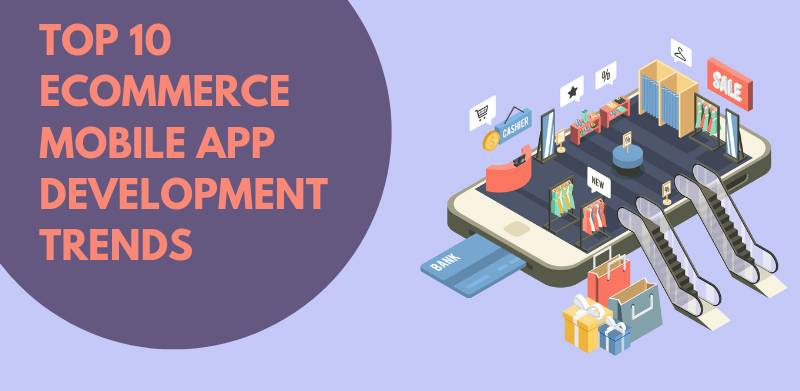Can you imagine a person living in the 21st century without a smartphone? Seems like it’s impossible. Mobile phones are no longer only for calls or text messages; today, people make purchases online using these devices. Both small and large online retailers simply can’t run their business without focusing on smartphones and mobile applications.
Mobile commerce is considered to be the future of eCommerce. 257.3 million U.S. citizens own smartphones, whereas 2.1 billion people worldwide are smartphone users. The majority of them use mobile applications on an ongoing basis. That’s why using them to promote their business is something you should turn your head to.

If you are a goal-oriented person, you might understand that it is not enough just to develop an application. First, it must be up-to-date and meet the users’ demands. The eCommerce landscape is constantly changing, and you should keep up with these changes.
Top Mobile eCommerce Trends You Must Pay Attention to in 2019
If your goal is to make shopping online easier for your clients, you should make yourself familiar with the main trends that will help you increase your sales. The majority of them stay on such lists year after year, but there are also some trends that are new.
Voice Search
Thanks to the advancements in natural language processing, we can now do a variety of things just with our voice commands. For instance, Amazon, Google Home, and Starbucks have already recognized the potential of this technology and implemented it into their products.
What’s the deal? By integrating voice search into your mobile application, you’ll make it more convenient for your customers to place their orders. This is especially true if your customers are likely to be shopping on the go, or they are just too busy to type and scroll looking for the item they need.
Shoppable Videos
Though this trend was popular last year as well, today, it is still in great request among online retailers. It is a type of video content that a company puts on its website or social media pages. While watching such videos, users can point at the item they’d like to have with their cursor, and they can follow the link that is automatically displayed to buy this item. In this case, they will be directed to another page with the product description or details for placing an order.
The key mission of shoppable videos is to make a customer buy the product right away and reduce the number of actions he or she has to take to do this.
New Payment Methods
The more payment methods you offer, the more convenient it will be for the customers to buy your product. Surely, debit or credit cards still remain the most popular payment method, but we simply can’t neglect the popularity of digital wallets (Apple Pay, Google Pay) or instant lay-by services (Afterpay or ZipPay).
And what about cryptocurrencies? Cryptocurrencies are virtual-only currencies that use cryptography and blockchain for security. Its biggest advantage is the decentralized nature and that they are not backed up by any fiat currency or financial institution.
Besides, the fees for crypto-payments are typically lower than in the case of traditional transactions. This is why this payment method is becoming more and more popular among some target groups, and your potential customers may be crypto enthusiasts as well. In this case, allowing them to pay with cryptocurrency may become the reason for their loyalty to your brand.
Virtual and Augmented Reality
We can’t ignore the benefits of such achievements as the VR or AR technologies. If your key objective is to make the customer experience more engaging, using VR or AR might be a good solution.

First, let’s cover the basics. AR adds a few digital elements to a live view by using your smartphone camera. VR is dedicated to a complete immersion into a virtual world. In other words, you can dive into a new world using Oculus Rift, HTC Vive or other VR glasses.
These technologies can be implemented in the following ways to benefit eCommerce business owners:
- Your customers can learn about the product’s benefits through AR showrooms and see if it is a good fit for them. Such AR showrooms are great for businesses selling accessories, clothes, furniture, etc.
- As for VR, it can be used to allow your potential customers to “use” your product in a fully digital environment. The perk is, they won’t even have to leave their flats or take a leap of faith hoping the product is what they are looking for.
Chatbots
Powered by AI, chatbots are already helping companies interact with their customers without the need for hiring any human customer support employees. Chatbots can answer typical questions in a matter of seconds and guide the user through the whole search and purchasing process, all 24/7/365.
The key benefit of AI-powered chatbots is that they can simulate a conversation with your customers in a natural way. Besides, they solve customers’ problems faster. For instance, you must have some busy customers who want to get their question answered right now. If you satisfy their need the way they want, they are more likely to become loyal to your brand - it’s as simple as that.
Machine Learning
2019 is the best time to use the superpowers of machine learning. If you implement this trend, you’ll find out how good every customer’s experience is and what behavioral patterns this person follows.
One of the best use cases is using machine learning algorithms in email marketing campaigns. These algorithms will automatically spot those patterns. For instance, it can analyze the purchase history of your customers and determine that a particular person orders the same product every month. Then, it will send a reminder email to this person on a monthly basis, thus enhancing the chances of making more customers of yours loyal.
SaaS
This software distribution model is here to help you during the eCommerce development. Basically, if you acquire a certain solution on the SaaS basis, you pay a subscription fee on a regular basis for using it.
When it comes to SaaS in the context of eCommerce mobile app development, things get interesting. It is common to use SaaS solutions during the development as many ready-for-integration technologies are distributed this way. For instance, if you want to add predictive analytics or dynamic pricing to your app, chances are your best option will be a SaaS solution.
Internet of Things
IoT is making the world around us more connected than ever, and it can benefit you by providing tons of personalized data on each of your customers. All the devices connected to an IoT network collect information and exchange it, which allows machine learning-based algorithms to determine each person’s patterns of behavior more accurately.
The key perk is that you get data not only on online customers’ behavior but what they do offline as well. This means that you’ll be able to provide them with more tailored search results and make your marketing campaigns microtargeted and more efficient.
Cloud integration (used by the best eCommerce mobile apps!)
Cloud storage is not something only users with limited space on their phones are interested in anymore. Companies switch to hosting both their data and even their whole apps in the cloud as well.
The benefits of this approach are the same for all mobile apps, not just eCommerce ones: you can streamline the operations (thus increasing your app’s performance) and reduce costs associated with hosting. And the faster your app is, the better the customer experience gets as well - no one likes lagging and slow apps.
On-demand apps
In this context, ‘on-demand’ is not that much about the technologies rather than the business model behind the app itself. On-demand apps are platforms that connect customers with sellers or service providers they need. Just have a look at such bigwigs as Taxify or Uber - they are the typical examples of on-demand apps.
The reason these apps are so popular is the convenience for the customer and the constant influx of clients for sellers/service providers. More and more industries welcome this trend. Although most on-demand apps are service-related at the moment, this is exactly eCommerce business owners can take over a very young niche with no competition at all.
How to Develop eCommerce Mobile App: Guide for Entrepreneurs
A customer-oriented development company should follow the latest trends and implement them during the development if potentially beneficial. Keep in mind, trends are something that can draw the attention of potential customers to your product.

When it comes to development in general, you should understand that there are some must-have features that you need to include:
- Simple registration. If your application demands too much information from users or registration takes more than a minute, some of them won’t even bother to complete it.
- Different payment options. When your app offers multiple payment options, it will be more convenient for your customers to buy the chosen item. Modern eCommerce apps usually support different international currencies such as USD, Euro, YEN, AED, GBP, etc. The most popular payment modes are credit/debit cards, eWallets, PayPal, Payoneer, and cryptocurrencies.
- Integration with social media. When social media are integrated, users will be able to share your offers with others. Besides, you can enable users to login into your mobile app via Twitter, Facebook, Google+ or any other social network. As a result, the registration will be faster and easier for them.
- User-friendly interface. Simply put, it shouldn’t be cluttered with the abundance of unnecessary icons. You should provide your users with fascinating experience; while browsing through your application, they should immediately find the solution to their problems.
- Reviews. Your users should be able to review your company. Giving them an opportunity to deliver instant feedback eliminates a number of calls to your support desk. As a result, you and your team members will also get insights into what you need to change to improve the customer experience.
- Simple checkout. High-quality products aren’t the only thing which attracts customers. They should also feel satisfied after using your app. A clutter-free checkout funnel and fast navigation are what makes the user experience fascinating.
- Analytics tools. Most of them are free and provide you with comprehensive statistics on your users. It will help you find out more about your customers’ preferences, see their total number, learn more about their location, navigation paths, etc. You’ll also learn what features of your app are used most of all. Read more about popular app analytics tools in our article.
Without these features, your mobile application just won’t be as successful as you’d like it to be. Keep in mind that a top-quality eCommerce mobile app is not only about the trends but also about the options you offer.
More than 20% of U.S. users have retailer apps installed on their devices. Some of them even use more than 11 apps simultaneously. Therefore, investing in eCommerce mobile apps is a necessity rather than a good-to-have thing.
Conclusion
Considering the popularity of mobile devices, many entrepreneurs should also keep up with the times and invest in the development of eCommerce mobile apps. They will help you boost sales, improve customer loyalty and solve customer issues faster. Besides, a good mobile app with a number of features, simple navigation, and innovative trends is very likely to be successful in the market.
If you are currently searching for a reliable software development company, our company is at your disposal. Our mission is to help our clients keep up to date with modern eCommerce trends.







